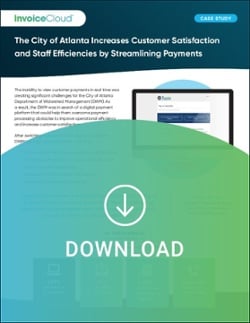The immediacy of today’s technology has changed customer expectations across most industries. Whether it’s the ability to instantly check your bank statement or to order dinner by pressing a button on your phone, modern consumers have grown accustomed to incredible, immediate customer experiences.
This certainly holds true for payments. Customers making online payments expect – and oftentimes demand – high-level payment processing functionalities.
For utilities, this often manifests as a customer’s expectation to view up-to-date utility bills and payment status whenever and wherever they’d like. This means utility organizations not only need to offer omni-channel options (so customers can access their bill just as easily on a mobile platform as they can on their computer), they also need to utilize real-time data to instantly provide the latest version and payment status of any bill.
Unfortunately for organizations struggling to keep pace, today’s heightened technological expectations mean that outdated systems are more likely to cause high levels of customer frustration. Without a user-friendly payment interface, utility organizations must manage the external ramifications of a poor customer experience and the internal inconveniences that outdated systems can cause.
The City of Atlanta Department of Watershed Management (DWM) was struggling with these very challenges, all due to their inability to offer customers access to their payments in real-time. This unmet demand was causing a negative online user experience, resulting in increased workloads for the DWM staff.
After working with InvoiceCloud, the City of Atlanta DWM saw an increase in self-service and e-payment adoption, higher customer satisfaction, reduced customer service call volume, and more.
Limited payment platforms cause customer frustration
The City of Atlanta’s DWM was functioning with an outdated payment platform – a major cause of frustration for both the city employees and its water utility customers. With their limited payment processing capabilities, it could take customers up to 7 days to view an updated bill, among other urgent payment obstacles.
The organization struggled with other challenges, including:
- Poor user experience leading to low customer satisfaction
- Increased customer service call volume
- Lack of self-service functionality increasing staff workload
- High costs associated with printing and mailing paper bills
The DWM needed an electronic bill presentment and payment (EBPP) platform that would easily integrate with their self-service portal, meet rising customer demand by providing real-time payment data, and provide a better self-service experience that would ease staff workloads.
Streamlined payments drive e-adoption
Outdated payment platforms are often the root of numerous challenges for utility providers. In the case of Atlanta’s DWM, their system’s poor user experience was negatively impacting adoption rates and frustrating customers, causing excess inbound calls and complicating internal processes.
After implementing with InvoiceCloud, the DWM has seen several benefits, including:
- Access to real-time payment data to provide better customer communication
- A better user experience that’s driving more digital payments
- Increased e-adoption for more efficient collections
- Simplified paperless enrollment to decrease print and mail costs
Investing in an EBPP platform with real-time data and streamlined payment functionalities was key in helping the DWM overcome their payment processing obstacles. Their new, expanded payment options resulted in a 614% spike in e-adoption, a 40% increase in customers setting up bill pay reminders, and a decrease in payment-related calls.
The DWM’s improved payment experience and enhanced customer communications drove these higher rates of self-service and, ultimately, saved the department time and resources in the process. Both customers and DWM employees now benefit from these streamlined payment functionalities, made possible by a seamless integration with their self-service customer portal.
Real-time data improves payment experience
The City of Atlanta DWM is a great example of how streamlined payment options and the use of real-time data can improve the customer experience, increase online payment adoption, and improve previously time-consuming internal processes.
To see the full results of this successful implementation, download the full case study below.

